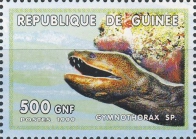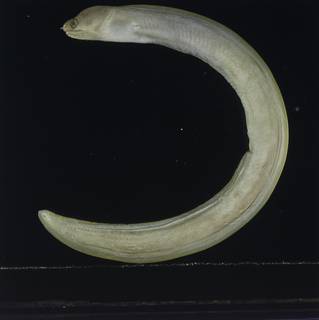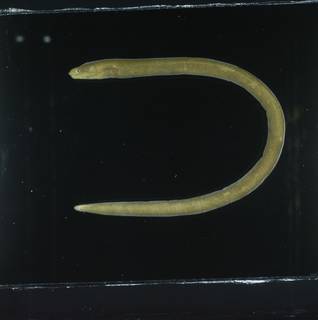WoRMS taxon details
Muraenidae Rafinesque, 1815
- Subfamily Muraeninae Rafinesque, 1815
- Genus Diaphenchelys McCosker & Randall, 2007
- Genus Echidna Forster, 1788
- Genus Enchelycore Kaup, 1856
- Genus Enchelynassa Kaup, 1855
- Genus Gymnomuraena Lacepède, 1803
- Genus Gymnothorax Bloch, 1795
- Genus Monopenchelys Böhlke & McCosker, 1982
- Genus Muraena Linnaeus, 1758
- Genus Pseudechidna Bleeker, 1863
- Genus Rhinomuraena Garman, 1888
- Genus Strophidon McClelland, 1844
- Genus Aemasia Jordan & Snyder, 1901 accepted as Enchelycore Kaup, 1856
- Genus Ahynnodontophis Fowler, 1912 accepted as Gymnothorax Bloch, 1795
- Genus Echida accepted as Echidna Forster, 1788 (misspelling)
- Genus Enchelicore accepted as Enchelycore Kaup, 1856 (misspelling)
- Genus Evenchelys Jordan & Evermann, 1902 accepted as Strophidon McClelland, 1844
- Genus Fimbrinares Whitley, 1948 accepted as Enchelycore Kaup, 1856
- Genus Gymnotorax accepted as Gymnothorax Bloch, 1795 (misspelling)
- Genus Heteromyrus Pietschmann, 1935 accepted as Gymnothorax Bloch, 1795
- Genus Limamuraena accepted as Limomuraena Kaup, 1856 accepted as Muraena Linnaeus, 1758 (misspelling)
- Genus Limmamuraena Kaup in Duméril, 1856 accepted as Muraena Linnaeus, 1758 (synonym)
- Genus Limomuraena Kaup, 1856 accepted as Muraena Linnaeus, 1758 (synonym)
- Genus Muraenophys accepted as Murenophis Cuvier, 1797 accepted as Muraena Linnaeus, 1758 (misspelling)
- Genus Murenophis Cuvier, 1797 accepted as Muraena Linnaeus, 1758
- Genus Neomuraena Girard, 1858 accepted as Gymnothorax Bloch, 1795
- Genus Poecilophis Kaup, 1856 accepted as Echidna Forster, 1788
- Genus Polyuranodon Kaup, 1856 accepted as Gymnothorax Bloch, 1795
- Genus Priodonophis Kaup, 1860 accepted as Gymnothorax Bloch, 1795
- Genus Pseudechilna accepted as Pseudechidna Bleeker, 1863 (misspelling)
- Genus Pseudechina accepted as Pseudechidna Bleeker, 1863 (misspelling)
- Genus Pseudoechidna accepted as Pseudechidna Bleeker, 1863 (misspelling)
- Genus Pseudomuraena Johnson, 1862 accepted as Gymnothorax Bloch, 1795
- Genus Rabula Jordan & Davis, 1891 accepted as Gymnothorax Bloch, 1795
- Genus Rhinomuraea accepted as Rhinomuraena Garman, 1888 (misspelling)
- Genus Sidera Kaup in Duméril, 1856 accepted as Gymnothorax Bloch, 1795 (synonym)
- Genus Sideria accepted as Sidera Kaup in Duméril, 1856 accepted as Gymnothorax Bloch, 1795 (misspelling)
- Subfamily Uropterygiinae Fowler, 1925
- Genus Anarchias Jordan & Starks, 1906
- Genus Channomuraena Richardson, 1848
- Genus Cirrimaxilla Chen & Shao, 1995
- Genus Scuticaria Jordan & Snyder, 1901
- Genus Uropterygius Rüppell, 1838
- Genus Ichthyophis Lesson, 1828 accepted as Scuticaria Jordan & Snyder, 1901
- Genus Scuticara accepted as Scuticaria Jordan & Snyder, 1901 (unaccepted > misspelling - incorrect subsequent spelling)
- Genus Uropteryginus accepted as Uropterygius Rüppell, 1838 (misspelling)
- Genus Uropterygus accepted as Uropterygius Rüppell, 1838 (misspelling)
- Genus Lycodontis Jordan & Evermann, 1896 accepted as Gymnothorax Bloch, 1795 (synonym)
- Genus Siderea Kaup, 1856 accepted as Gymnothorax Bloch, 1795 (synonym)
- Genus Thryrsoidea accepted as Thyrsoidea Kaup, 1856 accepted as Gymnothorax Bloch, 1795 (misspelling)
- Genus Thrysoidea accepted as Thyrsoidea Kaup, 1856 accepted as Gymnothorax Bloch, 1795 (misspelling)
- Genus Thyrosidea accepted as Thyrsoidea Kaup, 1856 accepted as Gymnothorax Bloch, 1795 (unaccepted > misspelling - incorrect subsequent spelling)
- Genus Thyrsoidea Kaup, 1856 accepted as Gymnothorax Bloch, 1795
- Genus Verdithorax Whitley, 1931 accepted as Gymnothorax Bloch, 1795
marine, brackish, fresh, terrestrial
Not documented
Description Worldwide in tropical and temperate seas. Diverse group of eels with large mouths with numerous teeth; often with fanglike...
Description Worldwide in tropical and temperate seas. Diverse group of eels with large mouths with numerous teeth; often with fanglike (canine) teeth. Dorsal fin origin usually before the gill openings; median fins confluent with caudal fin; no pelvic and pectoral fins. Gill openings as small roundish lateral openings. Head with 1-3 lateral line pores; absent on body. Scaleless. Recorded maximum length 3.0 m. Some morays cause ciguatera fish poisoning. A skin toxin was noted in an Indo-Pacific moray eel. Adults benthic, generally in shallow water among rocks and coral heads; many species are more active at night and hide in holes and crevices during the day. Vicious reputation is undeserved, although some species will bite if provoked. Feed mainly on crustaceans and small fishes. Larvae (leptocephali) epipelagic, widespread and abundant. [details]
Froese, R. and D. Pauly. Editors. (2024). FishBase. Muraenidae Rafinesque, 1815. Accessed through: World Register of Marine Species at: https://www.marinespecies.org/aphia.php?p=taxdetails&id=125431 on 2024-11-22
Date
action
by
![]() The webpage text is licensed under a Creative Commons Attribution 4.0 License
The webpage text is licensed under a Creative Commons Attribution 4.0 License
taxonomy source
Van Der Laan, R.; Eschmeyer, W. N.; Fricke, R. (2014). Family-group names of Recent fishes. <em>Zootaxa.</em> 3882(1): 1-230., available online at https://doi.org/10.11646/zootaxa.3882.1.1 [details] Available for editors  [request]
[request]
context source (PeRMS) Chirichigno, N.; Cornejo, M. (2001). Catálogo comentado de los peces marinos del Perú. <em>2ª ed. Instituto del Mar de Perú. Publicación Especial. Callao.</em> 314 p. [details]
basis of record van der Land, J.; Costello, M.J.; Zavodnik, D.; Santos, R.S.; Porteiro, F.M.; Bailly, N.; Eschmeyer, W.N.; Froese, R. (2001). Pisces, <B><I>in</I></B>: Costello, M.J. <i>et al.</i> (Ed.) (2001). <i>European register of marine species: a check-list of the marine species in Europe and a bibliography of guides to their identification. Collection Patrimoines Naturels,</i> 50: pp. 357-374 (look up in IMIS) [details]
additional source Fricke, R., Eschmeyer, W. N. & Van der Laan, R. (eds). (2024). ECoF. Eschmeyer's Catalog of Fishes: Genera, Species, References. <em>California Academy of Sciences. San Francisco.</em> Electronic version accessed dd mmm 2024., available online at http://researcharchive.calacademy.org/research/Ichthyology/catalog/fishcatmain.asp [details]
context source (PeRMS) Chirichigno, N.; Cornejo, M. (2001). Catálogo comentado de los peces marinos del Perú. <em>2ª ed. Instituto del Mar de Perú. Publicación Especial. Callao.</em> 314 p. [details]
basis of record van der Land, J.; Costello, M.J.; Zavodnik, D.; Santos, R.S.; Porteiro, F.M.; Bailly, N.; Eschmeyer, W.N.; Froese, R. (2001). Pisces, <B><I>in</I></B>: Costello, M.J. <i>et al.</i> (Ed.) (2001). <i>European register of marine species: a check-list of the marine species in Europe and a bibliography of guides to their identification. Collection Patrimoines Naturels,</i> 50: pp. 357-374 (look up in IMIS) [details]
additional source Fricke, R., Eschmeyer, W. N. & Van der Laan, R. (eds). (2024). ECoF. Eschmeyer's Catalog of Fishes: Genera, Species, References. <em>California Academy of Sciences. San Francisco.</em> Electronic version accessed dd mmm 2024., available online at http://researcharchive.calacademy.org/research/Ichthyology/catalog/fishcatmain.asp [details]
 Present
Present  Inaccurate
Inaccurate  Introduced: alien
Introduced: alien  Containing type locality
Containing type locality
Unreviewed
Description Worldwide in tropical and temperate seas. Diverse group of eels with large mouths with numerous teeth; often with fanglike (canine) teeth. Dorsal fin origin usually before the gill openings; median fins confluent with caudal fin; no pelvic and pectoral fins. Gill openings as small roundish lateral openings. Head with 1-3 lateral line pores; absent on body. Scaleless. Recorded maximum length 3.0 m. Some morays cause ciguatera fish poisoning. A skin toxin was noted in an Indo-Pacific moray eel. Adults benthic, generally in shallow water among rocks and coral heads; many species are more active at night and hide in holes and crevices during the day. Vicious reputation is undeserved, although some species will bite if provoked. Feed mainly on crustaceans and small fishes. Larvae (leptocephali) epipelagic, widespread and abundant. [details]



